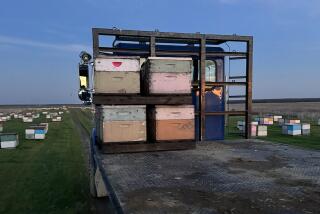Dangerous Honeys
- Share via
The suburbs are full of flowering plants. Bees make honey from flowers. Every once in a while, a swarm of bees will take up residence in some astonished suburbanite’s backyard.
So why shouldn’t the homeowners rent a beekeeper’s suit and harvest the honeycomb? After all, the bees are squatting on land. It’s pay to play, baby.
One reason not to harvest backyard honey is that among the charming profusion of ornamental plants in your neighbors’ landscaping, some might be dangerous. The nectar of certain flowers produces poisonous honey.
Well, it isn’t poisonous like arsenic, but it isn’t what you’d want honey to be either. If the bees have been visiting rhododendrons, azaleas, jessamine, strawberry trees, melaleuca trees, agave plants or privet, the honey may have strong, unpleasant flavors and can even be nauseating.
You’ve probably noticed that honey is usually sold in this country according to the flower, such as orange or clover, that the bees have been pollinating. (You’ll probably never see a label boasting of melaleuca honey.) This has a lot to do with the fact that commercial beekeepers often have contracts with farmers to pollinate fields which are usually planted in one particular crop. In many parts of the world, by contrast, there is no predominating flower, and what you have is always wildflower honey.
Turkey and Greece have a different system. They tend to market honey by the regions, or even villages, which produce traditional styles of honey. In Turkey, this is a sort of appellation controllee system, similar to those used for wines, and there are honey boutiques in Istanbul where you can shop for regional honeys.






